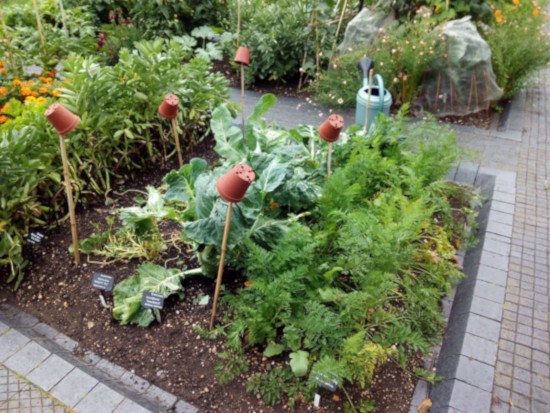Gardens for Learning: The Kew Guild Student Vegetable Plots

Hello Agrohuerters! The urban garden movement (or allotments, as they are called in England ) has infiltrated the grounds of Kew Gardens. In this case, in the form of student garden plots, a sanctuary for learning and best practice gardening in the Kew tradition. Do you want to meet him?

The Kew Guild Student Vegetable Plots
Established in 1963, the Kew Diploma in Horticulture is a 3-year course, in which students undertake both theoretical and practical activities in the immediate vicinity of the botanic garden. In this sense, several first-year students work at The Kew Guild Student Vegetable Plots on a daily basis, since five percent of their final diploma grade depends on their work in these beds.

For years the staff at Kew Gardens were aware that the Student Vegetable Plots, despite being well hidden, were popular with visitors and therefore deserved a better site. The plots were moved in May 2008 to a more accessible site, five minutes from one of the main gates and next door to Kew on a Plate Kitchen Garden and Bonsai greenhouse.

At the entrance are two elegant pre-rusted steel gates designed by student Emma Crawforth to defend the Student Vegetable Plots from carrot -hunting badgers. Various dividing materials run along the borders of the flower beds, and some fruit trees, such as espaliered apple trees, line the walls so students can practice the art of shaping and pruning.
Among the tasks they must carry out is the preparation of the land, the sowing of the seeds and the specific care of each of the crops in order to achieve a very good quality harvest. Every month, battling against gray London skies and an army of pigeons, students are tested on the quality and quantity of vegetables produced. Books aside, this is a wonderful opportunity for students to escape the classroom walls and bring to life what they have learned in the garden, with the added element of public display, so it is hoped that the plots will be attractive, which is whyaesthetic care is as important as crop productivity.

The pigeons here attack any type of Brassica genus, such as cabbages or broccoli, for this reason, we find many of these crops protected with nets. The designs of the parterres are very varied, and each gardener looks for inspiration where it best suits him. Some find it in architects like Martha Schwartz or Frank Lloyd Wright, others in the motifs on a Navajo-style blanket. Others simply like to mix colors and others approach their design in a practical way, to facilitate collection, although cunning also prevails,like the strategy of hiding the lettuce under tunnels of snow peas, a variety of peas whose pods are also eaten, to prevent them from being devoured by pigeons.
Trellising is very important in these flowerbeds, such as in the cultivation of courgettes, as they raise the leaves and obtain larger surfaces exposed to the sun to obtain better yields. They also cover the cabbages with wigwam- like “forests of sticks” to keep them out of the reach of pigeons, which you see are the big threat in the Student Vegetable Plots.

The Student Vegetable Plots are open to the public, so you can come and take a look during your visit to Kew Gardens. During the weekend, from 11 a.m. to 4 p.m., the students are in the flower beds so you can ask them for advice on different aspects such as planting or transplanting, among other techniques, so that you can get the most out of it. to your own garden. There are also activities for all ages to «inspire the art of farming». In addition, every Friday at lunchtime, around 12 pm, the students sell their weekly harvest of vegetables, tubers and fruits,whose profits are used to raise funds for study trips abroad.

How are Student Vegetable Plots evaluated?
In winter and early spring, evaluators look closely at seeding or planting depth, and good uniformity in seed distribution. Bed design and crop planning are also examined. All students must use the same collection of seeds, plus some that are optional. They must incorporate catch crops, which are fast-growing crops that are intercropped between two plantations of the same crop or between rows, such as radishes that grow very fast or millet; intercrops,which consists of growing two or more crops in proximity, that is, in high density to optimize the use of soil resources, and companion plants, which refers to the association of crops.
In the spring, the cultivation bed is prepared, so the evaluators look for a good planting surface, good tillage techniques, a fine finish and uniformity in terms of the grain of the land. They note that the seedbed is light, well consolidated but not compacted.

When summer arrives, students are tested on their use of space, efficient cultivation, and cultivation calendar. The intelligent use of successional planting must prevail against excessive growth that produces surplus crops. Pest and disease control at this time is key. And last but not least, does the garden look attractive?

I hope you enjoyed this walk through the Student Vegetable Plots at Kew Gardens. I wait for you in the next article!


![Photo of Alocasia Amazonica: [Characteristics, Planting, Care, Irrigation]](https://www.complete-gardening.com/wp-content/uploads/2022/08/alocasia-amazonica-characteristics-planting-care-irrigation-390x220.jpg)
![Photo of Agapanthus: [Cultivation, Care, Irrigation, Substrate, Pests and Diseases]](https://www.complete-gardening.com/wp-content/uploads/2022/08/agapanthus-cultivation-care-irrigation-substrate-pests-and-diseases-390x220.jpg)
